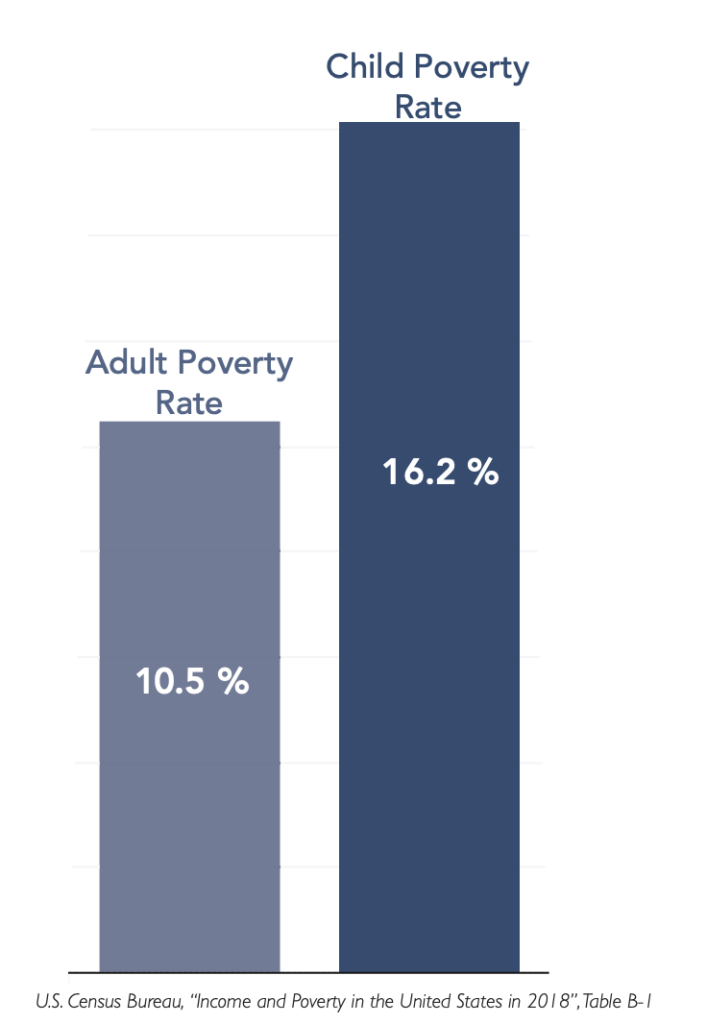First Focus on Children’s 13th annual Children’s Budget publication offers a comprehensive analysis of how kids and families have been faring in the federal budget over the past five years. The data tells an alarming story. As the children’s share of the federal budget continues to shrink, our analysis found that the share of spending on children has declined to an all-time low of 7.21 percent. The share of spending on children would have dropped even further to just 6.45 percent under the Trump Administration’s proposed FY 2020 budget. In addition, spending on children is not keeping up with rising costs and growing needs. Between FY 2018 and FY 2019, total spending on children experienced an inflation-adjusted cut of nearly 1 percent, which shows that spending on children is not even keeping pace with inflation. On top of this grim picture, as of FY 2018, we now are spending a larger share of the federal budget on interest on the national debt than on children’s programs.
We now spend more servicing the national debt than we do on the children who will inherit it.
The Official Poverty Measure, released by the U.S. Census Bureau earlier this year, reports that 16.2 percent of children (11.9 million) were living in poverty in 2018. Child poverty remains stubbornly high, and we know that children are 50 percent more likely to live in poverty than adults. We should be dedicating more, not fewer, of our federal resources to the well-being of our nation’s children and lifting them out of poverty. Without significant funding increases, critical children’s programs and services will continue to lose ground, and children and families will continue to struggle. Congress must take concerted, proactive steps to prioritize kids in federal budget decisions to help ensure our nation’s children have the resources they need to thrive.

Congress is likely to keep using the Continuing Resolution (CR) mechanism to stave off an impending government shutdown but risks a showdown at the end of the year. In the meantime, lawmakers must negotiate the funding allocations for all 12 annual spending bills. This is no easy task under normal circumstances, and current disagreements and political turmoil only will complicate the process further. We know that CRs translate into inflation-adjusted cuts and inhibit the ability of agencies to plan ahead. The 2019 Children’s Budget book tracks nearly 200 child-focused discretionary programs that could suffer if negotiations collapse and a third CR is necessary — or worse — if the government shuts down again.
In addition to those 200 children’s programs at risk of funding cuts, Congress must address the urgent need for a full and direct appropriation for the 2020 census which also has significant implications for our children in every district, territory, and state. The goal of the census is to count every person, regardless of citizenship status, in all our communities once and only once, and to collect basic information about them in a secure, convenient and confidential manner. A fair, accurate and comprehensive census is imperative because the data determines Congressional reapportionment, guides state and local government representation, and impacts the equitable distribution of hundreds of billions of federal dollars. First conducted in 1790, the census collects data that informs decision‐makers at all levels of government and affects a wide range of policies, including education, health care, and infrastructure. The information also influences private sector investments contributing to communities’ economic development and employment opportunities for the next decade. Inadequate and/or delayed funding for the 2020 census carries substantial consequences for the next decade and beyond, and kids will disproportionately experience the harmful and long-lasting effects of another inaccurate count.
As the Census Bureau heads into peak operations for the successful implementation of the once-a-decade census, the agency urgently needs the certainty of full funding and control of those resources to manage unprecedented and emerging challenges. Given the importance and far-reaching impact of the decennial census, it is seriously troubling that we consistently fail to count children accurately. Children, especially children of color, have the highest net undercount of any age group. Alarmingly, this problem continues to grow. The net undercount for young children has been increasing since 1980, with the census missing more than two million young children in 2010. At the same time, we have witnessed continued improvements for the counting of adults.
With child poverty remaining a persistent problem and more than a million children experiencing homelessness each year, many children live in conditions that make it more likely the census will miss them. In particular, the census is especially likely to miss children under the age of five if they live in complex or multi-family homes, live temporarily with others, live with grandparents, are poor, move frequently, are children of color, or are linguistically isolated. This historic and escalating undercount of children needs to be corrected because children deserve fair government representation and access to vital resources. We must do better in 2020 to overcome this long-term disparity facing our nation’s youngest.
There also is mounting concern that the 2020 census will miss many immigrant families and their children. Distrust of some federal agencies continues to swell in many communities, stemming largely from the current Administration’s aggressive and cruel immigration enforcement tactics and policies. One policy proposal, in particular, that has jeopardized the accurate count of children in immigrant families is the administration’s push to include a citizenship question on the census questionnaire. Although the Supreme Court formally struck down this proposal in June, forcing the administration to remove it from the 2020 questionnaire, the damage is already done with respect to the chilling effect stemming from the proposal. Coupled with this chilling effect, other hostile policies and actions toward immigrants will likely dramatically depress participation of immigrant and mixed-status families who fear negative repercussions from revealing their citizenship status.
For the first time, the 2020 census will be conducted online. While phone and paper responses remain an option, online delivery presents new challenges for the Census Bureau, including unreliable broadband service and infrastructure in some communities, lack of internet access and technological literacy in some households, cybersecurity threats, and budget shortfalls that prevented the government from testing systems and operations thoroughly. On a brighter note, many parents of young children have smartphone access to the internet even when they do not have access at home. There is room to hope that the convenience of filling out the form on a smartphone will help improve the count of young children.
In consideration of recent trends in funding for children and the undercount of children in past surveys, inadequate federal funding and a delay in the availability of much-needed resources for the Census Bureau risk doing further damage. Since Congress did not reach a budget caps deal until late in the fiscal year, limited time existed for appropriators to draft and pass spending bills for FY 2020. At the time of this writing, the House Commerce, Justice, Science and Related Agencies appropriations bill (CJS), which funds the Census Bureau, has passed out of the full chamber with $7.5 billion provided for the census for FY 2020, and the Senate bill includes $6.7 billion for the census. In anticipation of a second CR, the 2020 census must receive full and direct funding for the entirety of FY 2020. The Census Bureau conducts the census under statutory and constitutional deadlines for reporting results so the timing of this funding is critical. As in the past, Congress should provide for full and direct funding of the census under any new CR, and those funds should be in addition to the $1.02 billion in unspent funds for the 2020 Census carried over from FY 2019.
Beyond the immediate funding concerns, there remains a need for adequate funding in FY 2021. The Census Bureau relies on those future resources to manage the critical follow-up work that every census requires, including completion of data files for Congressional allocations and state redistricting. Insufficient funding now and in FY 2021 jeopardizes the success of the 2020 census, resulting in inaccurate and incomplete data that would impact public and private investment decisions and political representation for a decade to come.
On a positive note, the Census Bureau has established a Task Force on the Undercount of Young Children and is working to better target low‐response areas of the country and hard‐to‐reach populations, including young children. To help promote awareness of the census, encourage participation around the country, and improve the count of our kids, the Bureau is planning to launch a national media campaign in January 2020 and continues to pursue strategic outreach activities. The Bureau has developed materials to elevate the importance of counting all children, including infants, and aims to engage and motivate people to self-respond and include young children by associating participation in the census with benefits for one’s local community. The goal of these outreach strategies is to inform the public that high‐quality data better informs political representation and policy decisions, helps assess how our nation’s children and communities are changing and faring and ensures government resources reach those who need them most.
A successful 2020 decennial census requires full-year funding directly to the bureau to implement operational improvement plans that would help to ensure robust participation and maintain the value of the data as a foundation for our democracy, our economy and our political future. We must get it right.

